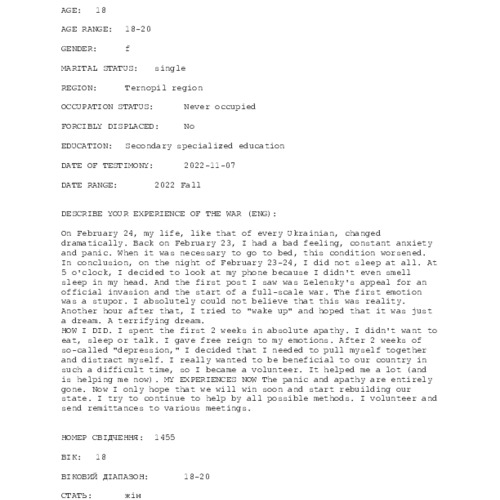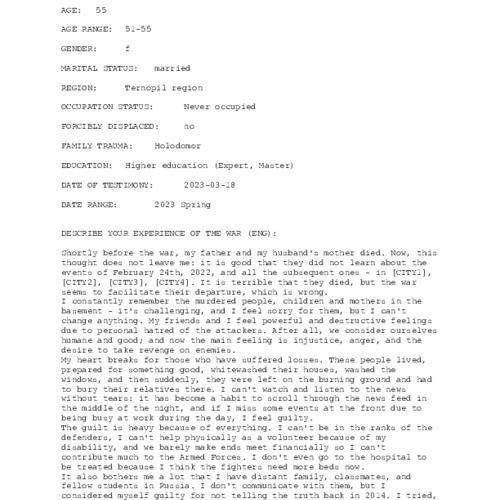Coping
This digital exhibit is to explore the emotional resilience of Ukrainian civilians during the Russia-Ukraine War. Oftentimes war is framed by large media outlets that focus on statistics and or political narratives, this exhibit aims to explore the indevidual experiences of Ukrainian civilians. Through four selected testimonies from the Narratives of War corpus, the exhibit brings forth the phychological impact of war by examining how indeviduals process despair, fear, guilt, fustration, and how they respond to these emotions through differant coping mechanisms.
Each testimony shows a unique story, but still feel connected by a shared emotional struggle to find purpose. One indevidual, forced to flee abroad with her child, volunteers to pack humanitarian aid and seek human connection to ease her guilt. Another, unable to physically help due to a disability, finds stregth to uplift those around her. Younger voices describe battles with depression and their path toward healing through volunteering and engaging in purposeful activities like cooking and weaving for soldiers.
This exibit seeks to provide a grounded view of the war where such indeviduals are often overlooked. By presenting these narratives, the goal is to humanize the stuggles of war, showing that there are other ways to cope that do not involve violence or hatred towards the opposition.
Additional Research Information:
Arifin, Andrew J. "Helplessness." CMAJ: Canadian Medical Association Journal 192, no. 21 (2020): E591+. Gale Academic OneFile (accessed May 16, 2025). http://dx.doi.org.libaccess.lib.mcmaster.ca/10.1503/cmaj.191617.
Gelbrich, Katja. "Anger, frustration, and helplessness after service failure: coping strategies and effective informational support." Journal of the Academy of Marketing Science 38, no. 5 (2010): 567+. Gale Academic OneFile (accessed May 16, 2025). http://dx.doi.org.libaccess.lib.mcmaster.ca/10.1007/s11747-009-0169-6.
Kimhi, S., Eshel, Y., Marciano, H., & Adini, B. (2023). Impact of the war in Ukraine on resilience, protective, and vulnerability factors. Frontiers in public health, 11, 1053940. https://doi.org/10.3389/fpubh.2023.1053940



